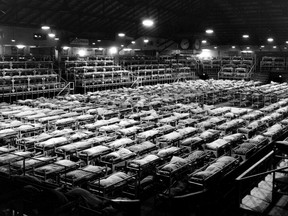Livestock barns and other PNE facilities housed 8,000 Japanese-Canadians for months during 1942-43. Vancouver city council has voted to approve a new historical display highlight the history of Japanese-Canadians in the city.

After the Japanese attacked Pearl Harbor and Hong Kong on Dec. 7-8, 1941, Canada went to war with Japan.
Vancouver had a large Japanese Canadian population that was well-integrated into the local community. Many of them had been born in Canada.
But on Feb. 16, 1942, Vancouver council unanimously voted to ask the federal government to “remove all residents of Japanese racial origin and enemy aliens to areas of Canada well-removed from the Pacific Coast.”
It did, sending all Japanese Canadians living on the west coast to camps in the B.C. Interior or east of the Rockies.
Before they went, up to 8,000 Japanese Canadians were imprisoned in the livestock barns and exhibition space on the Vancouver Exhibition grounds at Hastings Park.
The Japanese Canadian Hastings Park Interpretive Centre Society is looking to put up an interpretative centre in the old livestock barns. In July, the Pacific National Exhibition (today’s name for the Vancouver Exhibition) agreed to licence part of the barns to the society.
On Wednesday, Vancouver city council voted yes to Coun. Pete Fry’s motion that seeks “a commitment to support a Japanese Canadian Hastings Park Interpretive Centre.”
The motion instructs city staff to work with the Japanese Canadian Hastings Park Interpretive Centre Society and the PNE on the project, and to have the mayor write to senior levels of government and “identified funding partners” telling them of Vancouver’s support for the interpretative centre.
“They’ve already got a deal for a nominal lease with the PNE to do an interpretive centre in the barns,” said Fry. “This is really to just sort of align the City of Vancouver with some support, and even potentially some funding support, if council approves it.”
The motion notes that in 1988, Ottawa formally apologized to Japanese Canadians for its wartime actions, and in 2013, the City of Vancouver apologized “for its complicity, its inaction, and for failing to protect her residents of Japanese descent.”
Kiyoko Hanazawa has been advocating an interpretative centre at Hastings Park for years.
“We’ve been working through another organization since about 2010 on different projects about our history in Hastings Park,” she relates. “This latest thing about the actual space in the livestock building has been since 2021, when the PNE offered that space to us for an interpretive centre.
“It’s really important to us, because it’s living history. It’s where Japanese Canadians were during 1942-43.”
Some of the people interned in Hastings Park were there for months. Many were women and children — the men were often sent off “right away” to work on road construction in the Interior.
It was a bare-bones existence — hundreds of beds were lined up inside the livestock barns for people to sleep. They could go outside, but needed a special pass to leave Hastings Park.
Hanazawa said the project has evolved. Initially, they were looking at a 2,000-sq.-ft. display, but it may go up to 3,000 square feet. There would be some artifacts, but also video images and photos.
She said the centre would also have a “commemoration of the 8,000 people by name, that we could display on a wall or something like that.”
No date for a possible opening has been set.